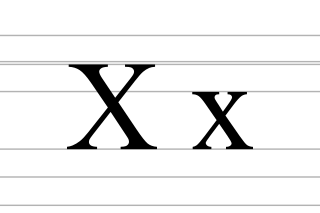Other uses
- Shenzhen Airlines, China (IATA:
ZH) - Zero Hedge , a financial blog started in 2009
- Zettahenry (ZH), an SI unit of electrical inductance
zh; endonym: Zhōngwén)ZH)
Wade–Giles is a romanization system for Mandarin Chinese. It developed from a system produced by Thomas Francis Wade, during the mid-19th century, and was given completed form with Herbert A. Giles's Chinese–English Dictionary of 1892.

X, or x, is the twenty-fourth letter of the Latin alphabet, used in the modern English alphabet, the alphabets of other western European languages and others worldwide. Its name in English is ex, plural exes.

Z, or z, is the twenty-sixth and last letter of the Latin alphabet, used in the modern English alphabet, the alphabets of other western European languages and others worldwide. Its usual names in English are zed, which is most commonly used in international English and zee, only used in American, sometimes Canadian and Caribbean English and with an occasional archaic variant izzard.
A caron is a diacritic mark commonly placed over certain letters in the orthography of some languages to indicate a change of the related letter's pronunciation.

Ll/ll is a digraph that occurs in several languages.
Uyghur is a Turkic language with a long literary tradition spoken in Xinjiang, China by the Uyghurs. Today, the Uyghur Arabic alphabet is the official writing system used for Uyghur in Xinjiang, whereas other alphabets like the Uyghur Latin and Uyghur Cyrillic alphabets are still in use outside China, especially in Central Asia.

A digraph or digram is a pair of characters used in the orthography of a language to write either a single phoneme, or a sequence of phonemes that does not correspond to the normal values of the two characters combined.
A voiced postalveolar fricative is a type of consonantal sound used in some spoken languages. The International Phonetic Association uses the term voiced postalveolar fricative only for the sound, but it also describes the voiced postalveolar non-sibilant fricative, for which there are significant perceptual differences.

Zhe, Zha, or Zhu, sometimes transliterated as Že is a letter of the Cyrillic script. It commonly represents the voiced retroflex sibilant (listen) or voiced postalveolar fricative /ʒ/, like the pronunciation of the ⟨s⟩ in "measure". It is also often used with D (Д) to approximate the sound in English of the Latin letter J with a ДЖ combination. Zhe is romanized as ⟨zh⟩, ⟨j⟩ or ⟨ž⟩.

The grapheme Ž is formed from Latin Z with the addition of caron. It is used in various contexts, usually denoting the voiced postalveolar fricative, the sound of English g in mirage, s in vision, or Portuguese and French j. In the International Phonetic Alphabet this sound is denoted with, but the lowercase ž is used in the Americanist phonetic notation, as well as in the Uralic Phonetic Alphabet. In addition, ž is used as the romanisation of Cyrillic ж in ISO 9 and scientific transliteration.
Gimel is the third letter of the Semitic abjads, including Phoenician gīml 𐤂, Hebrew gīmel ג, Aramaic gāmal 𐡂, Syriac gāmal ܓ, and Arabic ǧīm ج. Its sound value in the original Phoenician and in all derived alphabets, except Arabic, is a voiced velar plosive ; in Modern Standard Arabic, it represents either a or for most Arabic speakers except in Northern Egypt, the southern parts of Yemen and some parts of Oman where it is pronounced as the voiced velar plosive.
Že or Zhe (ژ) used to represent the phoneme, is a letter in the Persian alphabet, based on zayn (ز) with two additional diacritic dots. It is one of the five letters that the Persian alphabet adds to the original Arabic script, others being چ ,پ and گ, in addition the obsolete ڤ.

J, or j, is the tenth letter of the Latin alphabet, used in the modern English alphabet, the alphabets of other western European languages and others worldwide. Its usual name in English is jay, with a now-uncommon variant jy.
An IETF BCP 47 language tag is a standardized code that is used to identify human languages on the Internet. The tag structure has been standardized by the Internet Engineering Task Force (IETF) in Best Current Practice (BCP) 47; the subtags are maintained by the IANA Language Subtag Registry.

Abkhazian Dze is a letter of the Cyrillic script. It is used in Abkhaz where it represents the voiced alveolar affricate, pronounced like ⟨ds⟩ in "pods".
A hyperforeignism is a type of qualitative hypercorrection that involves speakers misidentifying the distribution of a pattern found in loanwords and extending it to other environments, including words and phrases not borrowed from the language that the pattern derives from. The result of this process does not reflect the rules of either language. For example, habanero is sometimes pronounced as though it were spelled with an ⟨ñ⟩ (habañero), which is not the Spanish form from which the English word was borrowed.
The Uyghur Latin alphabet is an auxiliary alphabet for the Uyghur language based on the Latin script. Uyghur is primarily written in Uyghur Arabic alphabet and sometimes in Uyghur Cyrillic alphabet.

Ⱬ is a Latin letter Z with a descender.
Ezh is a letter in the extended Latin alphabet, a variant of the Z/z with a tail